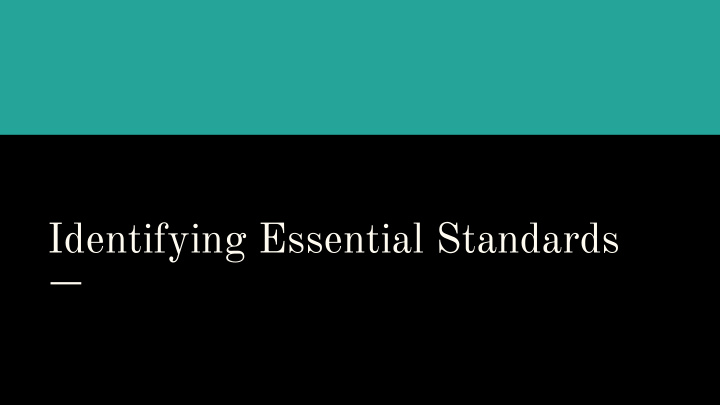



Identifying Essential Standards
Today’s Focus ● Understand and be able to articulate how essential standards fit into the PLC process and helps answer the four critical questions of PLCs. ● Understand and be able to articulate why the development of essential standards is a powerful practice. ● Understand how your team can use essential standards in your work.
Fundamental Assumptions: ● All students don’t learn the same way. ● All students don’t learn at the same speed. ● Some students lack academic behaviors. ● Some students have a home life that is counterproductive to academic success. ● Some students lack prior skills and knowledge.
Fundamental Assumptions ● Virtually all educators start each day with honorable intentions, work tirelessly on behalf of their students, and utilize the best strategies they possess. ● No teacher has all the skills, knowledge, and time necessary to meet the needs of all students assigned to his or her classes. SO: Ensuring that ALL students learn requires a systematic process that guarantees every child receives the additional time and support needed to learn at high levels.
Where do we start? Common Findings in Successful Schools: ● Marzano: guaranteed and viable curriculum based on a clear list of essential outcomes is the number one opportunity to raise the level of student achievement. ● Hattie: Achievement is enhanced to the degree that students and teachers set and communicate appropriate, specific, and challenging goals (Visible Learning) ● DuFour: Essential Skills ● Lezotte: Clear and focused academic goals ● Ainsworth: Power Standards
Why Develop Essential Standards? Four Key Questions of a Professional Learning Community: 1. What do we expect students to learn? 2. How do we know they are learning it? 3. How do we respond when they do not learn? 4. How do we respond when they have already learned?
Time and Viability The content that teachers are expected to address must be adequately covered in the instructional time teachers have available. Typical K-12 System: ● 3,500 benchmarks ● 13,000 hours of class time available ● 9,000 hours of instruction available ● 15,500 hours of instruction needed to cover the 3,500 benchmarks (22 years) ( Marzano, What Works in Schools, 2003)
Essential (Priority) Standards Defined Priority standards are a carefully selected subset of the total list of the grade‐specific and course‐specific standards within each content area that students must know and be able to do by the end of each school year in order to be prepared to enter the next grade level or course. (Ainsworth, Rigorous Curriculum Design, 2010)
Essential Standards Defined Standards that you are guaranteeing ALL students will know and be able to do at the end of the year. These are the standards you will write your common formative assessments around. You will provide “time and support” for students who haven’t mastered them and extension for those who already have.
Essential Standards Defined Essential Standards do not represent all that you are going to teach. They represent the minimum a student must learn to reach high levels of learning.
Guaranteed and Viable Curriculum 1. Unpack (To identify concepts and skills embedded in each standard; fosters deep understanding of standard before determining if it is essential 2. Identify essential standards (prioritize) 3. Create pacing guides (when will each power standard be taught) 4. Write high-quality assessments aligned to power standards. 5. Base intervention/enrichment on student data
Essential Standards Criteria Endurance Leverage Readiness for the next level of learning
Endurance Knowledge and skills of value beyond a single test date. Example: Describe how a narrator’s or speaker’s point of view influences how events are described (grade 5 literature)
Leverage Knowledge and skills of value in multiple disciplines. Example: Analyze the relationship between a primary and secondary source on the same topic (grades 6-8 ELA for history/social studies).
Readiness for the Next Level of Learning Knowledge and skills that are necessary for success in the next grade level or in the next level of instruction. Example: Demonstrate basic knowledge of one-to-one letter-sound correspondences by producing the primary sound or many of the most frequent sounds for each consonant (K-ELA)
Essential Standards Are... ● What teachers will spend the majority of instructional time teaching. ● What teachers will assess. ● What teachers will have data-driven discussions about. ● What teachers will intervene on (enrichment or remediation)
Quick Tip: When considering whether to select one similar standard over another, determine which one is the more comprehensive or rigorous one, not the one that is more foundational. (Ainsworth, Rigorous Curriculum Design, 2010)
Process 1. Individually, you decide. On your own , read each standard and mark those you believe best meet one of the criteria: endurance, leverage, or readiness. 2. Table Talk: Work as a team to reach consensus on which standards should be considered essential standards. 3. Review information from other sources (CAASPP blueprints, grade level standards above and below, previously identified power standards, current strengths and weaknesses in our own school/grade level data) 4. Work through the Essential Standards Chart for clarity on expectations and pacing.
Recommend
More recommend